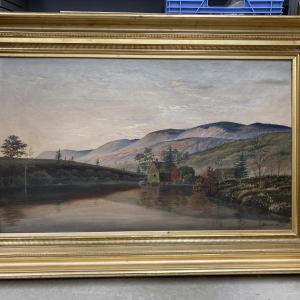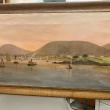Ezra Bramhall: A closer look at one of Camden's finest artists
 Painting by Ezra Bramhall located at the Camden Rockport Historical Society. (Photo courtesy Alison McKellar)
Painting by Ezra Bramhall located at the Camden Rockport Historical Society. (Photo courtesy Alison McKellar)
 Ezra Hall Bramhall
Ezra Hall Bramhall
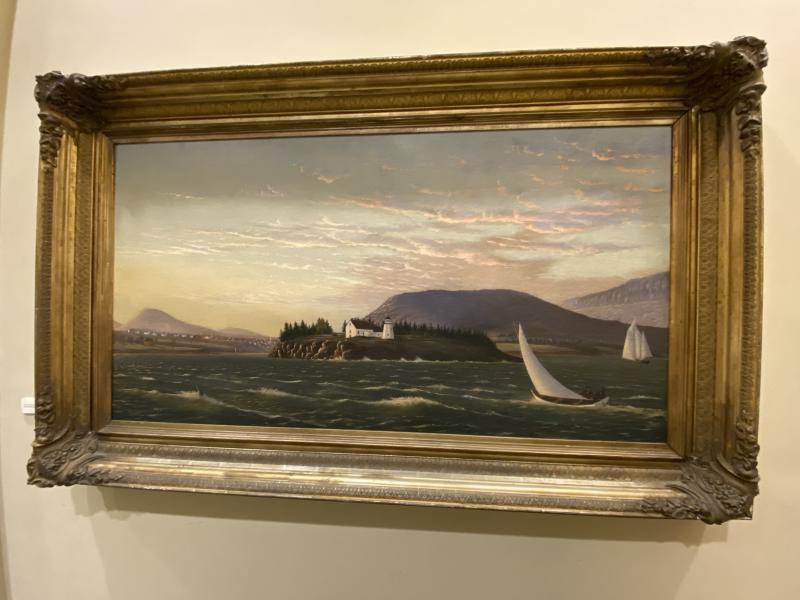 Bramhall painting that hangs in the stairwell of the Camden Public Library. (Photo courtesy Alison McKellar)
Bramhall painting that hangs in the stairwell of the Camden Public Library. (Photo courtesy Alison McKellar)
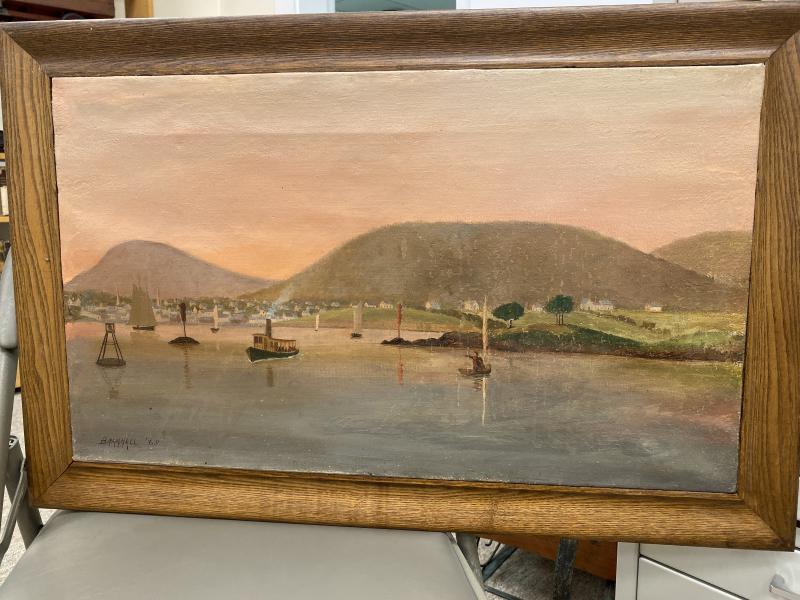 Painting by Ezra Bramhall located at the Camden Rockport Historical Society. (Photo courtesy Alison McKellar)
Painting by Ezra Bramhall located at the Camden Rockport Historical Society. (Photo courtesy Alison McKellar)

 Painting by Ezra Bramhall located at the Camden Rockport Historical Society. (Photo courtesy Alison McKellar)
Painting by Ezra Bramhall located at the Camden Rockport Historical Society. (Photo courtesy Alison McKellar)
 Ezra Hall Bramhall
Ezra Hall Bramhall
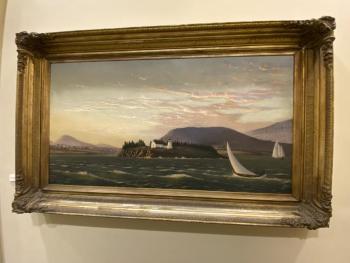 Bramhall painting that hangs in the stairwell of the Camden Public Library. (Photo courtesy Alison McKellar)
Bramhall painting that hangs in the stairwell of the Camden Public Library. (Photo courtesy Alison McKellar)
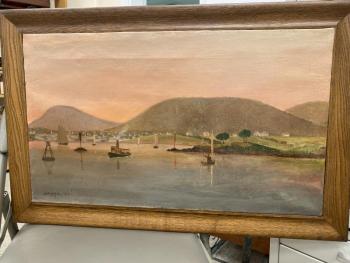 Painting by Ezra Bramhall located at the Camden Rockport Historical Society. (Photo courtesy Alison McKellar)
Painting by Ezra Bramhall located at the Camden Rockport Historical Society. (Photo courtesy Alison McKellar)

My New Years resolution is to write something every week about Camden and to not leave it half finished in a drafts folder in Google docs.
Almost pathologically, I am always researching something related to local history, but I rarely share what I learn in a way that it might be helpful to others. This arsenal of unfinished essays, albums, and notes continues to accumulate as I pursue old photos, newspaper clippings, and town meeting notes and they may eventually burn a hole in me, or worse, simply go to waste if I don't start sharing more of it.
My fascination with the natural history of Camden’s lakes, rivers, and mountains has led me often in search of Camden’s early artists and clues from a time when photography was not common. Much of my interest relates to the Mid-Coast Solid Waste lime quarries and the Megunticook River, but today, the story burning a hole in my soul is about a person.
Ezra Bramhall arrived in Camden almost a 100 years after the first settlers; too late to capture the untamed wilderness that came before us, but his paintings still depict a certain wildness not yet totally smothered by modern civilization. For some time, he was not only our town’s most important artist but a world renowned boat builder.
One of his spectacular landscapes hangs in the stairwell of the Camden Public Library and it will take your breath away if you let it; maybe even a little more so if you know something of the man behind it.
It depicts the Camden mountains and harbor from just beyond Curtis Island through the eyes of a man who knew the town from the inside, in a way that traveling artists like Fitz Henry Lane never could.
Bramhall was a working artist. The son of Elmira Hall and Captain Joshua Bramhall, of Belfast, he developed a talent for drawing at an early age.
A sign painter, a boatbuilder, an engineer, and political philosopher, he believed in somewhat of utopian vision of an evolving, cooperative society. Upon his death in 1906, the November 20th edition of the Courier Gazette called him “genial, kind-hearted and of an unassuming manner, an honest and public spirited citizen” declaring that Camden had lost “one of her most esteemed and talented citizens.” I can’t help but imagine that Ezra Bramhall and Sam Manning would have been great friends.
He was born in Belfast in 1846 and at some point his whole family moved to Camden. His father, Joshua, was a well respected captain who later had the job of tending the Curtis Island Lighthouse. He married Emma Swan in in 1870 and had two children, Louis P. and Howard E. Bramhall. Emma died just six weeks after the birth of their second child in May 1874.
It was during this time that he painted some of his masterpieces, many of which are held by the Camden Rockport Historical Society.
The next time you visit the library or the Historical Society, you can imagine Bramhall painting these stunning landscapes, a single father employed at the Anchor Factory but making time to pursue his art, gazing out at the island lighthouse where his father was caretaker. As a new board member at historical society, helping with spring cleaning felt like a special privilege, and it was the thrill dusting around these treasured paintings that inspired me to dig a little deeper into Bramhall's life.
In 1880, he started his own boatyard on Atlantic Avenue, specializing in steamships. It was at the head of the harbor in what is now occupied by Harbor Park and the American Boat House.
He excelled at everything from sign painting to engine design, and was famous for building all kinds of yachts, from dinghies to steamships. He was a Renaissance man and the ultimate jack-of-all-trades who could do build any sort of custom creation. He even built the pontoon boats for the famous swinging bridge of Curacao.
One nationally distributed paper described his work in an article about Camden:
“Mr. Bramhall has the most scientific methods of modeling vessels, and is not surpassed by any other builder in this country. All the essential features are carefully considered and furnished at the lowest possible cost. He has a good location, and intends on having all the work done in his own yard, including boiler, brass, and iron foundries… He is a practical mechanic, with wide experience; designs his own models, engines, and boilers…. Mr. Bramhall is known throughout the world, as his work has gone far and wide. We should, however, mention that he built four boats for the island of Curacao, a Dutch island in the Caribbean Sea, which were acknowledged to be superior in every way. He built the famous pontoon bridge… and many other countries have tested the work of Mr. Bramhall.”
Several references to Bramhall in digitized newspapers and government records. He was asked for input on import tariffs in 1894 and his responses are included in the federal register. He lamented high interest rates and the concentration of wealth and blamed the economic slowdown on the government’s failure to protect workers from being exploitation caused by what he called “extreme usury and the concentration of wealth” noting that “wages are down” and “working men with families must practice meanness in order to save anything.”
It is interesting to note that in 1894 Camden would have just been fully engaged in the act of rebuilding itself from the Great Fire of 1892, providing much reason to reflect on the organization of society as he gazed across the harbor at a town attempting to rise from the ashes. Bramhall’s buildings were not impacted but the events gave opportunity to observe rapid reorganizing of of society, at least on a local level.
An excerpt from one of Bramhall’s letters published in the Knights of Labor in 1894:
“A man is an organism which we understand. The heart circulates the blood through the veins and arteries (the circulating medium) to all parts of the body without question, whether the different parts will do their work or not, for each and every part does its work as required with pleasure, after being supplied with rich blood. A just government will be founded on this principle and no other. We must consider a nation as an organism, each individual being a part of the whole.”
And in another, he strikes an optimistic chord:
“A cooperative commonwealth abolishes usury in any form, therefore poverty will soon disappear, for we are even now undergoing the last pains of the evolution from an individualistic state to a collective state, where labor gets all the benefits from its toil.”
Camden’s resurgence also depended heavily on borrowing, both on the part of individuals and the town as a whole. It is unclear whether his political views were long held or if they blossomed later in life, but they were well developed in a variety of publications. One day, hopefully we will digitize and make available all the archived editions of the Camden Herald and certainly many more gems of Bramhall’s writing will be discovered.
Bramhall again married and had a son with Abbie E. Holmes.
Tragically, and under circumstances I do not know, Abbie died young, followed just a year after by the death of their son Ivan at the age of six in 1898.
In 1904, he had an unsuccessful run for Judge of Probate as the Socialist Party candidate and in 1906 he died at the age of 60.
Several months before his death he wrote a will granting all property (including his collection of paintings) to his two sisters, one dollar each to both of his living children, and all of his tools for woodworking, drawing, and painting to his son Howard E., who was also an artist.
Ezra and much of his family is buried at the Mountain View Cemetery in Camden. His paintings are scattered around Camden and beyond.
My hope is to photograph and develop a directory of all of them so that they might be shared more widely. In time, I know we will uncover more about Ezra Bramhall, but for now, we know enough to hold him in high regard, visit him from time to time at Mountain View, and take very good care of his paintings.
There should be about 90 of them so keep your eyes peeled.
Alison McKellar lives in Camden and is a Select Board member.
Event Date
Address
United States

